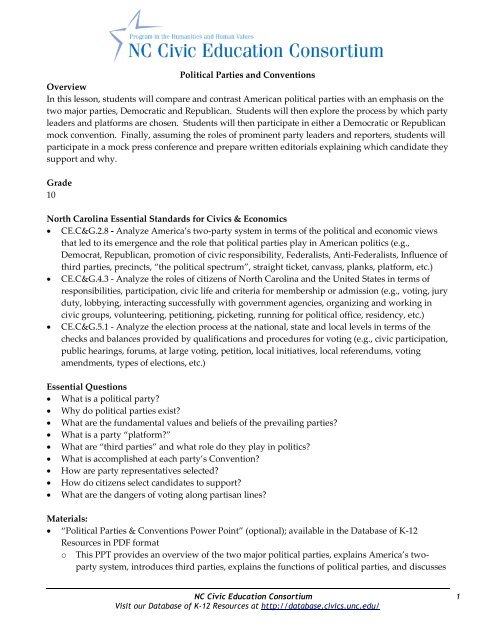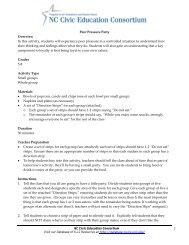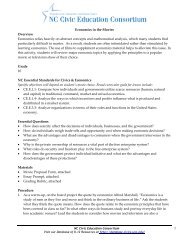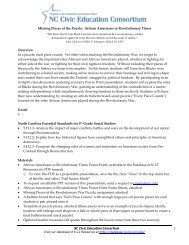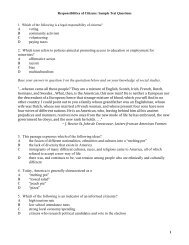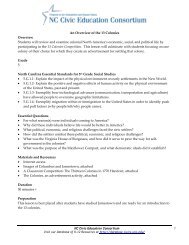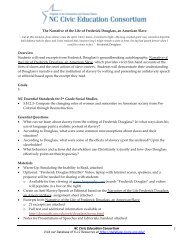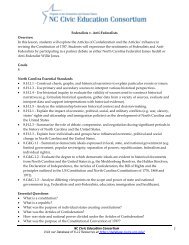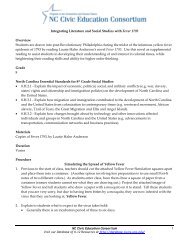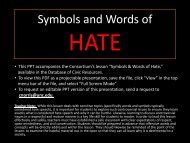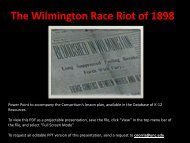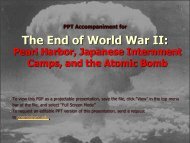Political Parties And Conventions Overview - Database of K-12 ...
Political Parties And Conventions Overview - Database of K-12 ...
Political Parties And Conventions Overview - Database of K-12 ...
- No tags were found...
You also want an ePaper? Increase the reach of your titles
YUMPU automatically turns print PDFs into web optimized ePapers that Google loves.
<strong>Political</strong> <strong>Parties</strong> and <strong>Conventions</strong><br />
<strong>Overview</strong><br />
In this lesson, students will compare and contrast American political parties with an emphasis on the<br />
two major parties, Democratic and Republican. Students will then explore the process by which party<br />
leaders and platforms are chosen. Students will then participate in either a Democratic or Republican<br />
mock convention. Finally, assuming the roles <strong>of</strong> prominent party leaders and reporters, students will<br />
participate in a mock press conference and prepare written editorials explaining which candidate they<br />
support and why.<br />
Grade<br />
10<br />
North Carolina Essential Standards for Civics & Economics<br />
CE.C&G.2.8 - Analyze America’s two-party system in terms <strong>of</strong> the political and economic views<br />
that led to its emergence and the role that political parties play in American politics (e.g.,<br />
Democrat, Republican, promotion <strong>of</strong> civic responsibility, Federalists, Anti-Federalists, Influence <strong>of</strong><br />
third parties, precincts, “the political spectrum”, straight ticket, canvass, planks, platform, etc.)<br />
CE.C&G.4.3 - Analyze the roles <strong>of</strong> citizens <strong>of</strong> North Carolina and the United States in terms <strong>of</strong><br />
responsibilities, participation, civic life and criteria for membership or admission (e.g., voting, jury<br />
duty, lobbying, interacting successfully with government agencies, organizing and working in<br />
civic groups, volunteering, petitioning, picketing, running for political <strong>of</strong>fice, residency, etc.)<br />
CE.C&G.5.1 - Analyze the election process at the national, state and local levels in terms <strong>of</strong> the<br />
checks and balances provided by qualifications and procedures for voting (e.g., civic participation,<br />
public hearings, forums, at large voting, petition, local initiatives, local referendums, voting<br />
amendments, types <strong>of</strong> elections, etc.)<br />
Essential Questions<br />
What is a political party<br />
Why do political parties exist<br />
What are the fundamental values and beliefs <strong>of</strong> the prevailing parties<br />
What is a party “platform”<br />
What are “third parties” and what role do they play in politics<br />
What is accomplished at each party’s Convention<br />
How are party representatives selected<br />
How do citizens select candidates to support<br />
What are the dangers <strong>of</strong> voting along partisan lines<br />
Materials:<br />
“<strong>Political</strong> <strong>Parties</strong> & <strong>Conventions</strong> Power Point” (optional); available in the <strong>Database</strong> <strong>of</strong> K-<strong>12</strong><br />
Resources in PDF format<br />
o This PPT provides an overview <strong>of</strong> the two major political parties, explains America’s twoparty<br />
system, introduces third parties, explains the functions <strong>of</strong> political parties, and discusses<br />
NC Civic Education Consortium 1<br />
Visit our <strong>Database</strong> <strong>of</strong> K-<strong>12</strong> Resources at http://database.civics.unc.edu/
political conventions. Teachers should edit the PPT (adding and omitting slides as they see fit)<br />
based on what students already know and need to known.<br />
o To view this PDF as a projectable presentation, save the file, click “View” in the top menu bar<br />
<strong>of</strong> the file, and select “Full Screen Mode”<br />
o To request an editable PPT version <strong>of</strong> this presentation, send a request to cnorris@unc.edu.<br />
Images <strong>of</strong> donkey and elephant, attached or available on Slide 4 <strong>of</strong> the “<strong>Political</strong> <strong>Parties</strong> PPT”<br />
“Democratic Party Platform” & “Republican Party Platform”, handout attached<br />
“Am I a Democrat or Republican”, article attached<br />
Venn Diagram graphic organizer<br />
“How <strong>Political</strong> <strong>Conventions</strong> Work,” reading attached<br />
Assignment Sheet for Convention Activity, attached<br />
Art supplies: markers, crayons, poster board, etc.<br />
Note Sheet for Party Platform Presentations<br />
Duration<br />
One 60 minute period for Day 1 (time will vary based on how much <strong>of</strong> the PPT is used and how in<br />
depth student discussion is.)<br />
Additional class time will be needed for the preparation and presentation <strong>of</strong> the political<br />
convention activity<br />
Procedure<br />
Day 1<br />
Democratic vs. Republican: What’s the Difference<br />
As a warm-up, write the words “<strong>Political</strong> Party” on the board and ask students to write down<br />
anything they know with regards to the phrase, either in small groups or as a class. (If utilizing<br />
the “<strong>Political</strong> <strong>Parties</strong> PPT,” this warm-up can be found on Slide 2.) Encourage students to think<br />
about what political parties are, why they exist, what their goals are, examples <strong>of</strong> different types<br />
<strong>of</strong> parties, prominent leaders <strong>of</strong> each party, which values each party represents, etc. When<br />
students are finished, have some <strong>of</strong> them read what they wrote. Write down relevant ideas on the<br />
board. This will be a good way to gauge prior knowledge and to get students participating for the<br />
day.<br />
Share the definition on Slide 3:<br />
<strong>Political</strong> Party: an organized group <strong>of</strong> people with common values and beliefs who try to get<br />
their candidates elected to political <strong>of</strong>fice<br />
Explain to students that political parties exist because people with common values and beliefs are<br />
more effectively able to express their ideals in groups as opposed to individually. Ask them to<br />
consider the following question: If you were trying to influence a political leader, or even the<br />
manger <strong>of</strong> the department store you worked in, do you think it would be better to have others<br />
working toward the same goal with you, or would it be better to “go it alone”<br />
Project the images <strong>of</strong> the donkey and the elephant on the overhead (attached or available on Slide<br />
4 if using the “<strong>Political</strong> <strong>Parties</strong> PPT.” Ask students if they know what the symbols represent,<br />
encouraging them to use context clues. If they cannot guess, explain to them that the images<br />
NC Civic Education Consortium 2<br />
Visit our <strong>Database</strong> <strong>of</strong> K-<strong>12</strong> Resources at http://database.civics.unc.edu/
epresent the two major political parties in America, the Democrats (donkey) and the<br />
Republicans (elephant).<br />
The Donkey— (Slide 5) Presidential candidate <strong>And</strong>rew Jackson was the first Democrat ever to<br />
be associated with the donkey symbol. His opponents during the election <strong>of</strong> 1828 tried to label<br />
him a "jackass" for his “stubborn” populist beliefs and slogan, "Let the people rule." Jackson<br />
was entertained by the notion and ended up using it to his advantage on his campaign<br />
posters. But cartoonist Thomas Nast is credited with making the donkey the recognized<br />
symbol <strong>of</strong> the Democratic Party. It first appeared in a cartoon in Harper's Weekly in 1870, and<br />
was supposed to represent an anti-Civil War faction. But the public was immediately taken by<br />
it and by 1880 it had already become the un<strong>of</strong>ficial symbol <strong>of</strong> the party.<br />
The Elephant— (Slide 6) <strong>Political</strong> cartoonist Thomas Nast was also responsible for the<br />
Republican Party elephant. In a cartoon that appeared in Harper's Weekly in 1874, Nast drew<br />
a donkey clothed in lion's skin, scaring away all the animals at the zoo. One <strong>of</strong> those animals,<br />
the elephant, was labeled "The Republican Vote." That's all it took for the elephant to become<br />
associated with the Republican Party. Source: http://www.infoplease.com/askeds/donkeyelephant.html<br />
Explain to students that the Democratic and Republican parties exist in response to some very<br />
fundamental questions about the role <strong>of</strong> government in citizens lives. The members <strong>of</strong> each party<br />
do not necessarily all feel the exact same way about every issue, but the parties have adopted<br />
some basic beliefs that usually reflect the beliefs <strong>of</strong> their members. In fact, each political party<br />
actually writes these beliefs down in list form to clarify what they stand for. This list is called a<br />
“platform.” Project Slide 7 and discuss:<br />
Party Platform: a list <strong>of</strong> the principles which a political party supports in order to appeal to<br />
the general public for the purpose <strong>of</strong> having a party's candidate(s) voted into <strong>of</strong>fice. This <strong>of</strong>ten<br />
takes the form <strong>of</strong> a list <strong>of</strong> support for, or opposition to, controversial topics. Individual topics<br />
are <strong>of</strong>ten called planks <strong>of</strong> the platform. The platform <strong>of</strong> a Party is discussed at each Party’s<br />
political convention, which will be discussed later in the lesson.<br />
Discuss:<br />
o What do you already know about the platforms <strong>of</strong> the two major political parties, Democrats<br />
and Republicans<br />
Tell students they are going to spend a bit <strong>of</strong> time exploring the differences (and similarities) in<br />
the two major political parties. Have students partner up and provide each set with the attached<br />
handouts: “Democratic Party Platform,” “Republican Party Platform,” and “Democrat or<br />
Republican” Instruct students to create a Venn diagram on notebook paper and to fill it in as<br />
they read through the handouts, noting all differences and similarities among the parties. Let<br />
students know that this exercise will give them insight into the major topics <strong>of</strong> each platform, as<br />
well as each party’s stance on the topics.<br />
After approximately 15 minutes, discuss as a class the major issues and how parties differ on each<br />
issue. You may want to create a “class” diagram on the board or overhead as you discuss. Further<br />
discuss:<br />
How do you think most people choose which party to align themselves with Do you think<br />
most Americans are educated regarding what the two parties stand for What if you agree<br />
with some <strong>of</strong> both parties issues<br />
NC Civic Education Consortium 3<br />
Visit our <strong>Database</strong> <strong>of</strong> K-<strong>12</strong> Resources at http://database.civics.unc.edu/
What stereotypes exist about Republicans and Democrats How do you think such stereotypes<br />
came to be<br />
Project the political cartoons on Slides 8 – 9 and have students discuss:<br />
What do you see/first notice about this cartoon<br />
What message is the artist trying to convey and what evidence makes you think this<br />
Do you think the artist is a Republican or a Democrat and why<br />
Next, ask students if any <strong>of</strong> them can identify any other political parties other than Democrats and<br />
Republicans. Further, ask if they can identify any past presidents who were from a party other<br />
than Democrat and Republican. Tell students they are going to learn a bit about the history <strong>of</strong><br />
political parties in the US and focus on America’s two-party system. Go through the following<br />
slides posing the discussion questions contained on each:<br />
Slides 10-11: Addressed the history <strong>of</strong> political parties<br />
Slides <strong>12</strong>-17: Explains America’s two-party system, the pros and cons <strong>of</strong> such, and introduces<br />
Independents and Third <strong>Parties</strong>.<br />
Slides 18-20: Explains the functions <strong>of</strong> political parties<br />
<strong>Political</strong> <strong>Conventions</strong><br />
Continue on the Slide 21, which provides an overview <strong>of</strong> the election process. (See also the<br />
Consortium’s lesson “The Electoral College.”)<br />
At Slide 22, ask students if they have heard <strong>of</strong> the term “convention” as it relates to political<br />
parties. Explain that the major political parties meet to set their agendas (make decisions<br />
regarding issues <strong>of</strong> concern for their party) and nominate candidates for political <strong>of</strong>fice at political<br />
conventions. Go through Slides 23-26 which provides an overview about conventions.<br />
Provide students with the attached “How <strong>Political</strong> <strong>Conventions</strong> Work” and instruct them to read<br />
and answer the corresponding questions. (This can be done individually in class or as homework,<br />
or in class in partners.)<br />
Day 2<br />
Prepare for Your Own <strong>Political</strong> Convention<br />
Begin the next class by going over the questions from “How <strong>Political</strong> <strong>Conventions</strong> Work,” going<br />
over anything that isn’t clear. Inform students that as a culminating group assignment, they are<br />
going to be hosting a mock Democratic and Republican Convention in class. They will work in<br />
groups <strong>of</strong> four to determine a platform and prepare a speech for either the Republican or<br />
Democratic Convention. On the assignment’s due date, students will host their convention by<br />
presenting their speeches to the convention (i.e., the remainder <strong>of</strong> class.)<br />
‣ Teacher Note:<br />
o Rather than having students create their own candidate speeches, teachers also have the<br />
option <strong>of</strong> further assigning each group an actual candidate to research and write a speech for.<br />
This will result in students not only familiarizing themselves with the party platforms, but<br />
also particular Republican and Democratic candidates.<br />
NC Civic Education Consortium 4<br />
Visit our <strong>Database</strong> <strong>of</strong> K-<strong>12</strong> Resources at http://database.civics.unc.edu/
o<br />
Teachers also have the option <strong>of</strong> including a third convention for Independents/Third <strong>Parties</strong><br />
(i.e. Libertarian, Green Party, Tea Party, etc.).<br />
Prior to class, teachers should determine how to divide students into groups <strong>of</strong> four. Options<br />
include:<br />
Have students draw slips <strong>of</strong> paper that determine whether or not they will work on the<br />
Democratic or Republican Convention, as well as assign them a group number. Explain to<br />
students that while they may end up assigned to a party that their own beliefs don’t align<br />
with, they can use this as an opportunity to learn more about their political opponents.<br />
Allow students to self-select whether they want to work on the Democrat or Republican<br />
Convention. They can then choose their own groups <strong>of</strong> four, or teachers can assign groups<br />
based on their Democratic or Republican preference. Teachers run the risk <strong>of</strong> an uneven<br />
amount <strong>of</strong> students choosing Democrat and Republican, but it is fine if one final convention is<br />
smaller than the other.<br />
Hand out the attached assignment sheet and go over it in detail with students. Let students know<br />
that on the assignment due date (aka, the opening day <strong>of</strong> the mock convention), each group will<br />
don their campaign materials and support each candidate as he/she delivers their speech.<br />
If possible, allow students access to computers with internet access for additional research. In their<br />
research, students may want to consult the websites for past or upcoming political conventions,<br />
such as:<br />
http://www.demconvention.com/<br />
http://gopconvention20<strong>12</strong>.com/<br />
‣ Teacher Note: Before students begin working independently, teachers may want to show an<br />
example from a speech from a past political convention. A simple internet search will provide<br />
numerous examples. Teachers can also provide handouts <strong>of</strong> excerpts from past convention<br />
speeches for an example. Transcripts <strong>of</strong> past convention speeches are available at:<br />
http://www.presidency.ucsb.edu/nomination.php.<br />
Teachers should determine how much class time and/or homework time students will have to<br />
prepare. On the due date, ask students to reconvene in their groups, with all Democratic groups<br />
meeting on one side <strong>of</strong> the room and Republican groups meeting on the other. Allow students 10-<br />
15 minutes at the beginning <strong>of</strong> class to complete final preparations for their convention. Teachers<br />
should assist both parties in determining the order <strong>of</strong> candidate presentations. (Whoever is chosen<br />
to go first should <strong>of</strong>fer a small message <strong>of</strong> welcome. Likewise whoever goes last should thank<br />
everyone for coming and conclude the convention.) Students can also use this time to work<br />
together and plan for any chanting or other staged convention actions.<br />
‣ Teacher Notes:<br />
o The final conventions can be held on different days, or can be presented on the same day by<br />
grouping all <strong>of</strong> one party’s speeches during the first half <strong>of</strong> class and the other party’s during<br />
the second half <strong>of</strong> class. Teachers should flip a coin to determine which convention is held<br />
first.<br />
o Teacher Note: If the class is spending a lot <strong>of</strong> time on this activity, you may want to allow<br />
them to decorate the classroom with balloons, streamers, etc.<br />
NC Civic Education Consortium 5<br />
Visit our <strong>Database</strong> <strong>of</strong> K-<strong>12</strong> Resources at http://database.civics.unc.edu/
Go over respectful audience behavior and explain to students the procedure for the convention<br />
presentations:<br />
When it is your party’s turn to present, each candidate will take turns going to the front <strong>of</strong> the<br />
room to deliver their speech.<br />
All audience members will assume the same party <strong>of</strong> the candidates who are presenting.<br />
Students who worked on the party opposite <strong>of</strong> those speaking should not challenge or heckle<br />
the presenters. (Listening to both party’s speeches will assist students in gaining a deeper<br />
understanding <strong>of</strong> each party’s platform.)<br />
While candidates present, audience members should take notes on the sheet provided (see<br />
attached).<br />
At the conclusion <strong>of</strong> the two conventions, students can then discuss which party they<br />
personally align with and why.<br />
At the conclusion <strong>of</strong> both conventions, discuss:<br />
What were the various issues identified in the speeches Are these issues that typically make<br />
up the party’s platform (Democrat or Republican)<br />
Which speech struck you most and why (Note whether student responses center around the<br />
content <strong>of</strong> their favorite speeches, or the presentation style. Discuss how these two aspects are<br />
also at play in real politics.)<br />
Were any major issues left out <strong>of</strong> either party’s conventions<br />
Overall, do you think political parties are a positive aspect <strong>of</strong> American elections Why or why<br />
not<br />
As a culminating writing assignment, have students respond to the following question:<br />
Based on what you’ve learned in class and participation in the two conventions, which party<br />
do you think best represents your interests Why If you do not find yourself aligning with<br />
either party, discuss why.<br />
Additional Resources:<br />
How do Caucuses Work: http://people.howstuffworks.com/question721.htm<br />
How <strong>Political</strong> Primaries Work: http://people.howstuffworks.com/primary.htm<br />
How the Electoral College Works: http://history.howstuffworks.com/american-history/electoralcollege.htm<br />
How the Green Party Works: http://people.howstuffworks.com/green-party.htm<br />
Full 20<strong>12</strong> Republican Party Platform: http://www.gop.com/wpcontent/uploads/20<strong>12</strong>/08/20<strong>12</strong>GOPPlatform.pdf<br />
Full 20<strong>12</strong> Democratic Party Platform: http://assets.dstatic.org/dnc-platform/20<strong>12</strong>-National-<br />
Platform.pdf<br />
NC Civic Education Consortium 6<br />
Visit our <strong>Database</strong> <strong>of</strong> K-<strong>12</strong> Resources at http://database.civics.unc.edu/
Abortion<br />
Strongly and unequivocally support Roe v. Wade.<br />
20<strong>12</strong> Democratic Party Platform<br />
Budget & Economy<br />
Create an economy built to last & built from the middle out.<br />
Civil Rights<br />
Enable disability access; plus 100,000 federal jobs.<br />
Equal treatment under law for same-sex couples.<br />
Corporations<br />
Auto manufacturers have paid back loans & drive the recovery.<br />
Education<br />
Turn around struggling public schools; expand public options.<br />
Double investment in Pell Grants & more tax credits.<br />
Energy & Oil<br />
Preserve ANWR but explore for oil responsibly elsewhere.<br />
Free Trade<br />
Double our exports by 2015 with new trade agreements.<br />
Government Reform<br />
Curb the influence <strong>of</strong> lobbyists; no to Citizens United.<br />
Gun Control<br />
Right to own firearms is subject to reasonable regulation.<br />
Health Care<br />
No arbitrary insurer cancelation; yes pre-existing condition.<br />
Preserve promise <strong>of</strong> Medicare; don't privatize or voucherize.<br />
Immigration<br />
DREAM Act for now; comprehensive reform next.<br />
Jobs<br />
Bridge to Work: help the long-term unemployed.<br />
Social Security<br />
Preserve promise <strong>of</strong> Social Security; don't privatize.<br />
Tax Reform<br />
Cut taxes for every working family, but not millionaires.<br />
Welfare & Poverty<br />
Partner with faith-based organizations to serve the needy.<br />
Source: http://ontheissues.org/20<strong>12</strong>_DNC_Platform.htm<br />
NC Civic Education Consortium 7<br />
Visit our <strong>Database</strong> <strong>of</strong> K-<strong>12</strong> Resources at http://database.civics.unc.edu/
20<strong>12</strong> Republican Party Platform<br />
Abortion<br />
Support human life amendment; oppose abortion funding.<br />
Budget & Economy<br />
Inflation is a hidden regressive tax.<br />
Audit the Federal Reserve; bring more transparency.<br />
Balanced Budget Amendment & super-majority for tax increase.<br />
Shrink the FHA, Fannie Mae and Freddie Mac.<br />
Civil Rights<br />
Constitutionally define marriage as one man & one woman.<br />
Corporations<br />
World's highest corporate tax rate cripples job creation.<br />
Crime<br />
Criminals behind bars cannot harm the public.<br />
Education<br />
Shift to community colleges and technical institutions.<br />
No federal college loans; just insure private loans.<br />
Energy & Oil<br />
Open ANWR and OCS for oil & gas development.<br />
Environment<br />
Conservation is a conservative value, but balance economics.<br />
Foreign Policy<br />
Transition to a post-Assad Syria and independent Lebanon.<br />
Model foreign aid on Millennium Challenge Corporation.<br />
Castro regime in Cuba is a state-sponsor <strong>of</strong> terrorism.<br />
Free Trade<br />
Restore presidential Trade Promotion Authority.<br />
Countervailing duties against China on intellectual property.<br />
Government Reform<br />
Keep Electoral College; no national popular vote.<br />
Repeal McCain-Feingold; no contribution limits.<br />
Require photo ID to fight voter fraud.<br />
No statehood for the District <strong>of</strong> Columbia.<br />
Gun Control<br />
Right to obtain and store ammunition without registration.<br />
Health Care<br />
Repeal ObamaCare; it is an attack on our Constitution.<br />
Homeland Security<br />
No aerial surveillance over US soil.<br />
Privatize the TSA and end frisking.<br />
Respond to proliferation <strong>of</strong> transnational terrorism.<br />
National Military Strategy to deter rogue aggression.<br />
Immigration<br />
Make E-verify mandatory nationwide.<br />
Jobs<br />
Support employee ownership over union elites.<br />
The best jobs program is economic growth.<br />
Principles & Values<br />
Support prayer in public schools.<br />
NC Civic Education Consortium 8<br />
Visit our <strong>Database</strong> <strong>of</strong> K-<strong>12</strong> Resources at http://database.civics.unc.edu/
The GOP is the Great Opportunity Party.<br />
Social Security<br />
Give workers control over their retirement investments.<br />
Technology<br />
Infrastructure via civil engineering, not social engineering.<br />
Invest in cutting-edge cybersecurity technologies.<br />
War & Peace<br />
Prevent Iran from building and possessing nuclear weapons.<br />
Welfare & Poverty<br />
Religious charities foster benevolence and patriotism.<br />
Source: http://ontheissues.org/20<strong>12</strong>_RNC_Platform.htm<br />
NC Civic Education Consortium 9<br />
Visit our <strong>Database</strong> <strong>of</strong> K-<strong>12</strong> Resources at http://database.civics.unc.edu/
Democrat or Republican<br />
So, you’ve heard the words Democrat and Republican. But, what do they mean Which political party best<br />
matches your views Perhaps you don’t align yourself with either<br />
Sometimes it is hard to tell the difference between the parties because the issues are infinitely more complex<br />
than the messages <strong>of</strong> 30-second campaign commercials on television or 8-second “sound bites” heard on the<br />
evening news. Additionally, politicians are always trying to say things that are popular and most political<br />
discourse in the United States is filtered through both the lens <strong>of</strong> the media and the notion <strong>of</strong> an “either-or” twoparty<br />
system.<br />
It is also incorrect to suggest that all Democrats share the same beliefs or that there are no factions within the<br />
Republican Party. In general, Democrats are more liberal in that they favor progressive change in society,<br />
freedoms from government intervention into one’s private and social life, and regulations on economic activity<br />
and businesses. In general, Republicans are more conservative in that they favor traditional institutions and the<br />
status quo, restrictions on private and social activities, and freedoms from government controls over economic<br />
activity and businesses. Yet, not all Democrats are liberal and all Republicans conservative. For instance,<br />
people – or both parties and political ideologies – in the American South tend to be more conservative, while<br />
their neighbors in the Northeast and West Coast are typically more liberal. Also, not everyone adheres to the<br />
principles <strong>of</strong> the two major parties and there are several minor or “third parties” in the United States, although<br />
they rarely get their candidates elected.<br />
Nonetheless, there are some noticeable differences in the political parties. In brief, Democrats tend to favor an<br />
active role for government in society and believe that such involvement – be it environmental regulations<br />
against polluting or anti-discrimination laws – can improve the quality <strong>of</strong> our lives and help achieve the larger<br />
goals <strong>of</strong> opportunity and equality. On the other hand, Republicans tend to favor a limited role for government in<br />
society and believe that such reliance on the private sector (businesses and individuals) – be it avoiding<br />
unnecessary environmental regulations or heavy-handed anti-discrimination laws – can improve economic<br />
productivity and help achieve the larger goals <strong>of</strong> freedom and self-reliance.<br />
Below are some issues that are frequently discussed by the news media and politicians. Every four years during<br />
a presidential election, both major parties convene at a national convention and draft a platform, which is an<br />
agenda for the next four years and spells out their positions on the issues <strong>of</strong> the day. The current party platforms<br />
reveal the parties’ positions on the following dozen controversial issues:<br />
Issues<br />
1. Abortion<br />
Democrats: Abortion is a woman’s right and should be legal<br />
Republicans: Abortion should be illegal and restricted by government<br />
2. Flag Burning<br />
Democrats: Flag burning is political speech and is protected by the Constitution<br />
Republicans: Protect the flag from burning by a constitutional amendment<br />
3. Gun Control<br />
Democrats: Favor/Gun control is needed<br />
Republicans: Oppose/Gun control is unconstitutional<br />
4. Natural Environment<br />
Democrats: Strong regulations are needed to protect the environment<br />
Republicans: Strong environmental laws harm the economy<br />
5. Race Relations<br />
Democrats: Strong anti-discrimination laws are needed<br />
NC Civic Education Consortium 10<br />
Visit our <strong>Database</strong> <strong>of</strong> K-<strong>12</strong> Resources at http://database.civics.unc.edu/
Republicans: People and businesses can be trusted not to discriminate<br />
6. Minimum Wage<br />
Democrats: Favor/Increase the minimum wage to help workers<br />
Republicans: Oppose/Do not raise the minimum wage because it hurts businesses<br />
7. Healthcare<br />
Democrats: Government should require universal access to healthcare<br />
Republicans: Private insurers are preferable to government mandates<br />
8. Taxes<br />
Democrats: Increase taxes on the wealthy to pay for public programs<br />
Republicans: Cutting taxes for everyone helps the economy<br />
9. Military<br />
Democrats: Cut military spending; expand veteran’s benefits; act in concert with other nations and/or<br />
with support from NATO and the UN<br />
Republicans: Increase military spending; cut veteran’s benefits; don’t be constrained by other nations or<br />
by NATO and the UN<br />
10. Death Penalty<br />
Democrats: Oppose/It is not a deterrent and innocent people are in jeopardy<br />
Republicans: Favor/The death penalty is necessary and effective<br />
11. Gay Rights<br />
Democrats: Favor/Gays rights and marriage are civil rights<br />
Republicans: Oppose/Marriage is a sacred trust between a man and woman<br />
<strong>12</strong>. Prayer in School<br />
Democrats: Oppose/Violation <strong>of</strong> the separation between church and state<br />
Republicans: Favor/It is a religious right and our Judeo-Christian heritage<br />
Think about whether you feel government has an inherent and fundamental role to play in society in promoting<br />
equality and opportunity, or whether such goals are best served by limited the role <strong>of</strong> government and relying on<br />
individuals, businesses, or even religious organizations. In what facets <strong>of</strong> society is more government<br />
involvement – be it support or regulation – needed In what facets <strong>of</strong> society is government too intrusive or<br />
unnecessary Think about each issue listed above and determine your position on the issue. By adding up your<br />
stance on these dozen issues you can get a rough sense <strong>of</strong> your political party affiliation.<br />
Copyright © 2004<br />
Florida Atlantic University<br />
Department <strong>of</strong> <strong>Political</strong> Science<br />
777 Glades Road Boca Raton, FL 33431<br />
NC Civic Education Consortium 11<br />
Visit our <strong>Database</strong> <strong>of</strong> K-<strong>12</strong> Resources at http://database.civics.unc.edu/
Introduction to How <strong>Political</strong> <strong>Conventions</strong> Work<br />
From “How Stuff Works” - http://people.howstuffworks.com/political-convention.htm/printable<br />
The political convention is a uniquely American tradition, one that is focused on the political parties that have<br />
defined Americans' choices in government for nearly 175 years. <strong>Political</strong> conventions, and the party system they<br />
are an integral part <strong>of</strong>, are not mentioned in the U.S. Constitution. Indeed, the founding fathers <strong>of</strong> American<br />
government viewed political parties with distrust or outright hostility. Yet today, Americans can hardly imagine<br />
a government without political parties, and the parties' conventions are enormous, televised media events.<br />
In this article, we'll learn how political conventions came about, how they have changed, and what they are used<br />
for. We'll also look at some famous events at political conventions in American history.<br />
Functions <strong>of</strong> <strong>Conventions</strong><br />
Originally, the main purpose <strong>of</strong> political conventions was to nominate the party's candidate for president. In<br />
the 1800s, the movement in the United States was to place more political power directly in the hands <strong>of</strong> the<br />
citizens. <strong>Political</strong> conventions were one way <strong>of</strong> doing this: Previously, candidates were nominated in secret<br />
caucuses by members <strong>of</strong> Congress; candidates would now be chosen by delegates who were selected at the state<br />
or county level by the party members.<br />
The democratization <strong>of</strong> presidential elections eventually took the nominating function away from the<br />
conventions. People wanted more direct control over their party's nominees, so the presidential primaries came<br />
into use (although some states still use caucuses). Party members vote in the primaries to choose whom they<br />
want to represent their party in the upcoming election. By the time <strong>of</strong> the convention, there is no suspense about<br />
who will be the nominee -- it has been known for months.<br />
<strong>Political</strong> conventions serve other purposes beyond nominating the party candidate, which is why they're still<br />
around. The convention <strong>of</strong>fers party members a chance to gather together and discuss the party's platform. The<br />
platform is the party's stance on the political issues <strong>of</strong> the day. For a long time, the convention was a place for<br />
political debate, and important decisions were made there. In 1860, the Democratic Party debated the<br />
government's right to outlaw slavery. When the party adopted the position that the Supreme Court could decide<br />
the slavery issue, delegates from several southern states walked out, resulting in the Southern Democratic Party.<br />
In 1980, Senator Edward Kennedy fought against incumbent Jimmy Carter's economic plan. Although Carter<br />
defeated Kennedy for the nomination, Kennedy's debate forced Carter to radically change his plan.<br />
Today, even this function <strong>of</strong> the convention has been largely stripped away. The conventions have been<br />
streamlined, with important events and speeches scheduled for prime-time television hours. The parties work to<br />
eliminate any evidence <strong>of</strong> debate or disunity within the party. The political conventions have now been reduced<br />
to the status <strong>of</strong> infomercials, marketing the ideas and personalities <strong>of</strong> the party to the public. While the<br />
conventions serve to unify the party and generate party pride, the "advertisement for the party" has become the<br />
primary function <strong>of</strong> political conventions today.<br />
Now we'll look at who gets to go to the conventions, and what they do there.<br />
Media at the <strong>Conventions</strong><br />
The original closed-door caucuses in the early 1800s were mentioned only briefly in newspapers, and only<br />
through indirect accounts. As the process became more open, media coverage became more widespread. The<br />
<strong>of</strong>ten chaotic atmosphere <strong>of</strong> the conventions was difficult to get across in a printed article, however.<br />
NC Civic Education Consortium <strong>12</strong><br />
Visit our <strong>Database</strong> <strong>of</strong> K-<strong>12</strong> Resources at http://database.civics.unc.edu/
That changed when television arrived. Suddenly, the circus <strong>of</strong> a national party convention was broadcast into<br />
homes around the country. Every floor debate, interruption, protest and delegate squabble was there for public<br />
viewing. This gradually led to the changes in the primaries we see today -- no more debates or arguments, no<br />
unplanned speeches or interruptions, and protesters are kept miles away from the convention floor. Now, the<br />
convention is a media event, attended by almost as many reporters as delegates, and broadcast in carefully<br />
selected prime-time viewing slots.<br />
Nuts and Bolts <strong>of</strong> <strong>Political</strong> <strong>Conventions</strong><br />
The national political conventions are made up <strong>of</strong> delegates from each state. Those delegates are selected in<br />
different ways, depending on the party and the state. The key here is that the delegates are not only party<br />
members; they are supporters <strong>of</strong> a particular candidate.<br />
The Democrats use a proportional system, in which the percentage <strong>of</strong> party members in favor <strong>of</strong> a candidate in<br />
the primary or caucus is reflected in the percentage <strong>of</strong> delegates representing that candidate who will be sent to<br />
the convention. For example, if two candidates split the primary vote, then each gets half <strong>of</strong> the delegate<br />
positions for that state.<br />
Republicans favor a winner-take-all system, although they do allow states the option <strong>of</strong> using a proportional<br />
system. Under a winner-take-all system, the candidate with the majority <strong>of</strong> votes in the primary or caucus gets<br />
all <strong>of</strong> the state's delegate seats.<br />
Deciding how many delegates each state gets is a very complicated process. Essentially, the number is based on<br />
the state's population, as well as how much support that state has given to party candidates in recent elections.<br />
Now we know who gets to go; but how do they decide where they're going In the age <strong>of</strong> modern travel and<br />
mass communications, the national conventions no longer need to be held in centrally located cities. The main<br />
factors today are:<br />
<br />
<br />
<br />
<br />
Infrastructure - Does the city have the hotel and convention space, as well as the public transportation,<br />
needed to host thousands <strong>of</strong> people<br />
Security - Can the site be adequately protected from terrorists or protesters<br />
Funding - Can the city provide the millions <strong>of</strong> dollars in additional funding that the parties typically<br />
receive from the host city<br />
Preference - According to Congressional Quarterly, "for the party that controls the White House, <strong>of</strong>ten<br />
the overriding factor in site selection is the president's personal preference."<br />
What do today's delegates do at the convention They may discuss party issues, listen to speeches, and<br />
participate in party "pep rallies." But for the most part, nothing political actually happens at political<br />
conventions in the 21st century. The convention concludes with a carefully planned speech by the party's<br />
nominee for president.<br />
Historic <strong>Conventions</strong><br />
Perhaps the most infamous political convention was the 1968 Democratic National Convention in Chicago<br />
(see below), but there have been other important events at conventions. In 1888, abolitionist and former slave<br />
Frederick Douglass became the first black person to receive a vote at a political convention -- a single vote at<br />
the Republican convention.<br />
In 1908, Democrats added legislation to their platform that would separate the interests <strong>of</strong> corporations from<br />
those <strong>of</strong> Republicans. They felt that corporations and the Republicans were too closely allied, a theme that<br />
remains relevant almost 100 years later.<br />
NC Civic Education Consortium 13<br />
Visit our <strong>Database</strong> <strong>of</strong> K-<strong>12</strong> Resources at http://database.civics.unc.edu/
In 1940, two unique events occurred at political conventions. First, Franklin D. Roosevelt was nominated for a<br />
third term as president. After some debate over his choice <strong>of</strong> vice president, he accepted. Second, the<br />
Republicans held the first ever televised convention that year.<br />
The 2000 Democratic Convention in Los Angeles was marked by extensive protests in support <strong>of</strong> numerous<br />
causes. Pro-union, gay rights, anti-corporate welfare, pro-environmental and other movements made their voices<br />
heard a good distance from the convention site, due to the heavy presence <strong>of</strong> security fences and police <strong>of</strong>ficers.<br />
A performance by the politically active rock group Rage Against the Machine was interrupted by police, who<br />
used pepper spray and fired rubber bullets at fleeing spectators.<br />
In the next section, we'll take a look at how political conventions got started in the first place.<br />
History <strong>of</strong> <strong>Political</strong> <strong>Conventions</strong><br />
Despite the reluctance <strong>of</strong> the early leaders <strong>of</strong> the United States to accept political parties, two had sprung up<br />
within a few decades <strong>of</strong> the country's founding. These initial parties were loosely defined, and it's difficult to<br />
pinpoint exactly when they came into being. By the late 1790s, however, the parties were becoming more<br />
organized and taking a greater role in American politics.<br />
From 1796 to 1824, candidates for presidential elections were chosen by congressional caucuses -- that is, the<br />
members <strong>of</strong> Congress for a given party gathered together and decided whom to nominate for the presidential<br />
election. The electoral college system was then used to choose the president from among the candidates.<br />
The caucus system began to break down because the American people felt that it took too much power out <strong>of</strong><br />
their hands. In 1816 and 1820, they were right. The Federalist Party had collapsed, leaving only one political<br />
party -- the Democratic-Republican Party (this party is not related in any way to the Democrats and<br />
Republicans <strong>of</strong> today). As a result, whoever was nominated by the Democratic-Republican caucus would be<br />
guaranteed to win the presidency. James Monroe won in 1816, and was similarly unopposed in 1820. Americans<br />
protested the caucus system around the nation.<br />
That period <strong>of</strong> single-party rule not only led to political conventions, but also created the feeling that a twoparty<br />
system was crucial to American politics. During the transition period, after the death <strong>of</strong> caucuses but<br />
before conventions were instituted, state legislatures nominated presidential candidates.<br />
Ironically, the first political convention was held by a third party, the Anti-Mason Party, in 1831. Soon after, the<br />
National Republicans and the Democrats also began holding conventions. In these early days, the conventions<br />
were <strong>of</strong>ten held as much as a year prior to the election because transportation was so difficult. For this same<br />
reason, they were usually held in centrally located cities. Baltimore held most <strong>of</strong> the early conventions, while<br />
Chicago became the most popular host after the Civil War.<br />
Today, presidential primaries have made the conventions unnecessary for practical purposes. They exist<br />
primarily as a marketing tool and a political pep rally, where each party puts on a well-choreographed show.<br />
Answer on notebook paper:<br />
1. What was the original purpose <strong>of</strong> political conventions<br />
2. In what ways did the development <strong>of</strong> presidential primaries change the function <strong>of</strong> conventions<br />
3. What are the purposes <strong>of</strong> political conventions today<br />
4. What is a party platform<br />
NC Civic Education Consortium 14<br />
Visit our <strong>Database</strong> <strong>of</strong> K-<strong>12</strong> Resources at http://database.civics.unc.edu/
5. What happened to the role <strong>of</strong> debate in conventions and why do you think this is the case<br />
6. How has the role <strong>of</strong> the media influenced what takes place at conventions<br />
7. What are delegates<br />
8. How does the selection <strong>of</strong> delegates for the Democratic and Republican Party differ<br />
9. What determines the number <strong>of</strong> delegates a state receives<br />
10. How are each Party’s convention locations selected<br />
11. What do convention delegates do at the conventions<br />
<strong>12</strong>. Of the historic conventions mentioned, which do you think would have been most interesting to attend and<br />
why<br />
13. Although primaries have made conventions unnecessary for practical reasons, what purposes do they still<br />
serve<br />
NC Civic Education Consortium 15<br />
Visit our <strong>Database</strong> <strong>of</strong> K-<strong>12</strong> Resources at http://database.civics.unc.edu/
Hosting a <strong>Political</strong> Convention<br />
‣ Circle your assigned party: Republican Party Democratic Party<br />
1. Decide who in your group will assume the following roles:<br />
Party Leader - responsible for keeping the group on track and ensuring<br />
everyone contributes to each step<br />
Party Secretary - responsible for writing down ideas discussed in<br />
group<br />
Candidate - responsible for presenting party platform via a speech to<br />
class<br />
Head <strong>of</strong> Marketing - responsible for ensuring creation <strong>of</strong> campaign<br />
materials<br />
‣ Roles only designate which student is in charge <strong>of</strong> leading the group in<br />
getting a particular aspect <strong>of</strong> the convention done. ALL students are expected to participate and contribute<br />
equally to each task below.<br />
2. What will the Democratic or Republican platform focus on this year<br />
Within your group, develop a platform for your party. What are the best things about America What are<br />
America's biggest problems How will your party address the problems and enhance the positive What are<br />
the major issues that bind the members <strong>of</strong> the Democratic or Republican Party together that your group<br />
thinks are most important<br />
Refer to what you learned about your party in class (or conduct further research) and select 3 issues to<br />
comprise your party’s platform. These will represent the issues that your party will prioritize at the<br />
Convention. (Examples might include lowering taxes, universal healthcare, prochoice or prolife issues, etc.)<br />
Remember, political parties use conventions as a way to publicize the party's platform and leaders, so you<br />
must determine what the major issues <strong>of</strong> your platform are and be prepared to get convention attendees<br />
motivated and excited about (or about improving) these issues.<br />
3. Prepare an opening day convention speech based on the platform you have selected for your party.<br />
The purpose <strong>of</strong> your speech is to get convention attendees excited about your party and the issues your<br />
party will be tackling if elected to <strong>of</strong>fice. The best convention speeches are informative, interesting,<br />
inspirational, and memorable.<br />
To capture and sustain the interest <strong>of</strong> your audience, you should create and include a slogan (i.e. Candidate<br />
Obama’s slogan, “Yes we can!”) If the other members <strong>of</strong> your party are to chant this slogan at particular<br />
times during the speech, this should be pre-planned as well.<br />
You might also want to consider using humor, inspirational words, stories that illustrate why your party’s<br />
issues are important, words <strong>of</strong> hope and encouragement, etc.<br />
Your speech should be approximately 3 minutes when delivered.<br />
While the “Candidate” will be delivering the speech, all group members must help in the creation <strong>of</strong> the<br />
content, as well as help the Candidate practice effective delivery.<br />
4. Develop campaign materials for the convention.<br />
<strong>Conventions</strong> are typically celebratory, including decorations and materials that feature the party name,<br />
party symbols, slogans, candidate names, etc. Sample materials might include banners, posters, pins, hats,<br />
t-shirts, mugs, etc.<br />
Create at least three separate items for display or use during the convention. During the candidate speeches,<br />
you will use the campaign items (i.e. wear a pin, hold a campaign sign, etc.)<br />
‣ The Convention will be hosted on _______________________________ (due date.)<br />
‣ What questions do you have about this assignment<br />
NC Civic Education Consortium 16<br />
Visit our <strong>Database</strong> <strong>of</strong> K-<strong>12</strong> Resources at http://database.civics.unc.edu/
Name: __________________________<br />
Notes for Democratic Convention<br />
Candidate Name:<br />
Issues/Platform<br />
What I liked/What was missing<br />
Candidate Name:<br />
Issues/Platform<br />
What I liked/What was missing<br />
Candidate Name:<br />
Issues/Platform<br />
What I liked/What was missing<br />
Candidate Name:<br />
Issues/Platform<br />
What I liked/What was missing<br />
NC Civic Education Consortium 17<br />
Visit our <strong>Database</strong> <strong>of</strong> K-<strong>12</strong> Resources at http://database.civics.unc.edu/
Name: __________________________<br />
Notes for Republican Convention<br />
Candidate Name:<br />
Issues/Platform<br />
What I liked/What was missing<br />
Candidate Name:<br />
Issues/Platform<br />
What I liked/What was missing<br />
Candidate Name:<br />
Issues/Platform<br />
What I liked/What was missing<br />
Candidate Name:<br />
Issues/Platform<br />
What I liked/What was missing<br />
NC Civic Education Consortium 18<br />
Visit our <strong>Database</strong> <strong>of</strong> K-<strong>12</strong> Resources at http://database.civics.unc.edu/


